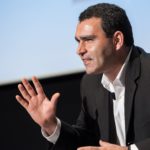In truth, I tend to get obsessed with topics of interest. Since my first conversation on storytelling a few weeks back with Douwe Bergsma, CMO of George Pacific, I have now read (via audio) two books, ordered three more and am in the middle of listening to a Great Course on the subject.
Just in case you want to dive in with me, here’s the list I’ve devoured thus far, all of which I can recommend to anyone in marketing:
- “Story-Selling: How To Sell Without Selling” by Nick Nanton & JW Dicks
- “All Marketers are Liars” by Seth Godin
- “The Art of Storytelling: From Parents to Professionals” by Professor Hannah B. Harvey
What you won’t find in any of these resources, is how an emphasis on storytelling could impact client-agency relationships, hiring practices and advertising measurement. For that, you’ll have to read part 2 of my delightfully informative interview with Douwe below.
Drew: Tell me a bit about how the agencies fit into this process.
Douwe: When we develop story frameworks, our design and advertising agencies are included, but not leading it. Our story framework experts at Character lead all the work at this phase. Then you brief your agencies on the story framework (the bottom of the iceberg) and ask them to come back with the tip – the storytelling — that everyone will see. They come back with the big idea and the campaign gets extended to all the marketing roles.
Drew: This sounds very different that most agency / client processes.
Douwe: Yes, it is different from what we used to do. We now have a major step between the our typical brand equity work and the design- and campaign development, which we call the story framework. And that leads to the stories you’ve recently seen. The conflicts on Angel Soft are pretty clear because it is our selling theme: “Be soft. Be Strong”. We are bringing it to life in terms of the struggles that parents have. In order to be a good parent, you have to be strong and yet you also have to be soft. We highlight that story through the most challenging parent relationships like a stepfather raising a stepdaughter. We take it to the extreme in terms of parenting challenges, and show how people have to be soft and strong in their context. This allows for a higher emotional connection than just promoting our toilet paper as being the right balance of softness and strength at a better value than the next best alternative.
Drew: How did this impact your agency relationships?
Douwe: We made the decision to expand our agency roster because some agencies are good at advertising, and some are good at storytelling. In our point of view, storytelling is a broader and a longer-term approach than advertising. Let me give you an example: If I give you five pages of a book and I say, hey, what do you think of it, you’d probably say, I don’t know, I read five pages. In traditional advertising, every page could feel like the same, with a benefit, a reason to believe and bringing some brand personality to life. With story telling you are expected to experience different chapters of the book to understand and appreciate the brand more and more over time, resulting in a stronger engagement and relationship.
Drew: Have you had to train your staff, your product managers or the people responsible for advertising development to think more about how to judge stories?
Douwe: Yes. There are multiple layers from an organizational growth perspective. But first and foremost, there was a challenge to convince people that this would be an improved alternative approach to communication. So that was one. The second was then when people were kind of like, “I am willing to give this a shot.” We basically took almost everybody in the organization through a three-day story immersion, called Character Camp, where they have former movie writers, TV writers, cartoon writers, improv artists, and standup comedians explain the power of story, how story writing and storytelling works, what the story framework is and then literally help us practice it. Then we have what we call a Brand Summit with all our brand builders, including agencies, and there was a whole training process to get there, and a hands-on coaching. On top of that, we assigned Shari Neumann to be in charge of all our content development. She’s not called our Chief Storytelling Officer, but that is basically her role.
Drew: That’s interesting. So you have to tell the story one chapter at a time?
Douwe: If you believe in true storytelling, what you do on Google or Facebook and what you do on network TV help deliver ‘chapters’ of the story. For example, we initiated partnerships with AOL and Meredith that combined with the things we put on our product page on Amazon complimented each other to tell the whole story. It’s only when you’re exposed to multiple touch points that you start to understand the value and the deeper meaning of the story. While ideally each individual communication by itself might be effective, it not as effective as the whole thing would be.
Drew: This must be tricky to orchestrate. Do you still evaluate the performance of the individual ads via things like copy testing?
Douwe: One of the key challenges we ran into is that we had to completely reconsider our qualification approach. Because we would qualify a 30-second ad in the past via testing and attribute some value to the ad. Today, however, you need to understand, for example, on-line search with Google, as well as the social media activities on Facebook, the partnership videos we developed with AOL and Amazon’s product pages. Then there’s eCommerce, the in-store experience and our package design. To fully appreciate the value of the brand and the meaning a brand could have in a consumer’s life, we have to consider all of these elements as part of the story. That was a big, big paradigm shift. Without this shift, we would not be able to turn storytelling into a competitive advantage in the marketplace.
 It was one of those rare Los Angeles days — smog free, blue skies and the air was crisp. A perfect set up for what I hoped would be a perfect pitch. We were sitting in a diner right across the street from the bank headquarters in Pasadena and we were the opposite of stressed out. Like well-prepared boxers, we were ready, really ready. We were confident in our strategic sharpness and that we had the big idea. We even had most of the critical tactical details worked out to deliver a successful launch campaign. So when we walked over to the bank about 15 minutes before the appointed hour, witnesses might have seen a slight swagger in our step. Little did we know that our swagger was about to be shattered.
It was one of those rare Los Angeles days — smog free, blue skies and the air was crisp. A perfect set up for what I hoped would be a perfect pitch. We were sitting in a diner right across the street from the bank headquarters in Pasadena and we were the opposite of stressed out. Like well-prepared boxers, we were ready, really ready. We were confident in our strategic sharpness and that we had the big idea. We even had most of the critical tactical details worked out to deliver a successful launch campaign. So when we walked over to the bank about 15 minutes before the appointed hour, witnesses might have seen a slight swagger in our step. Little did we know that our swagger was about to be shattered. Drew: So Darren, our given our panel title, does story trump data?
Drew: So Darren, our given our panel title, does story trump data?